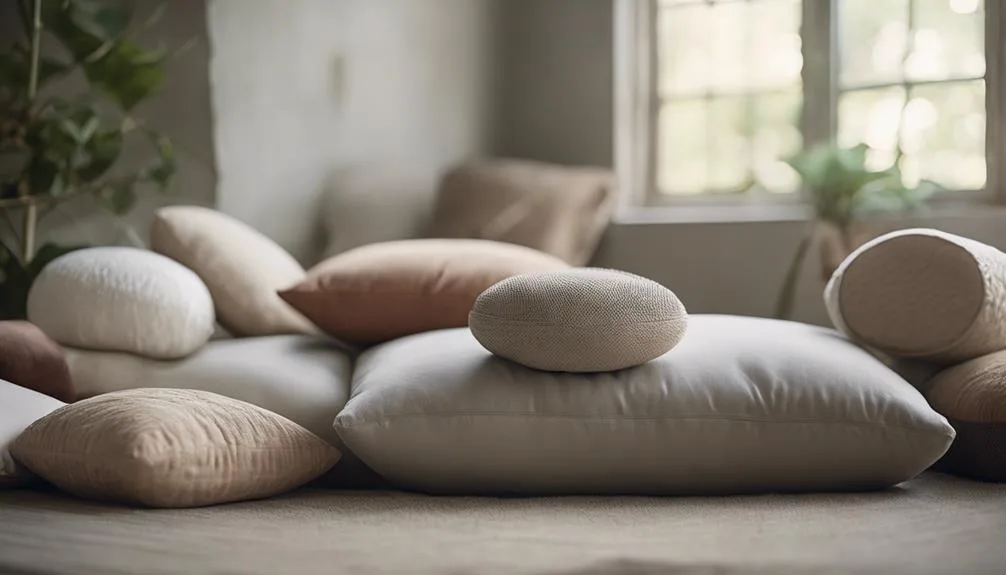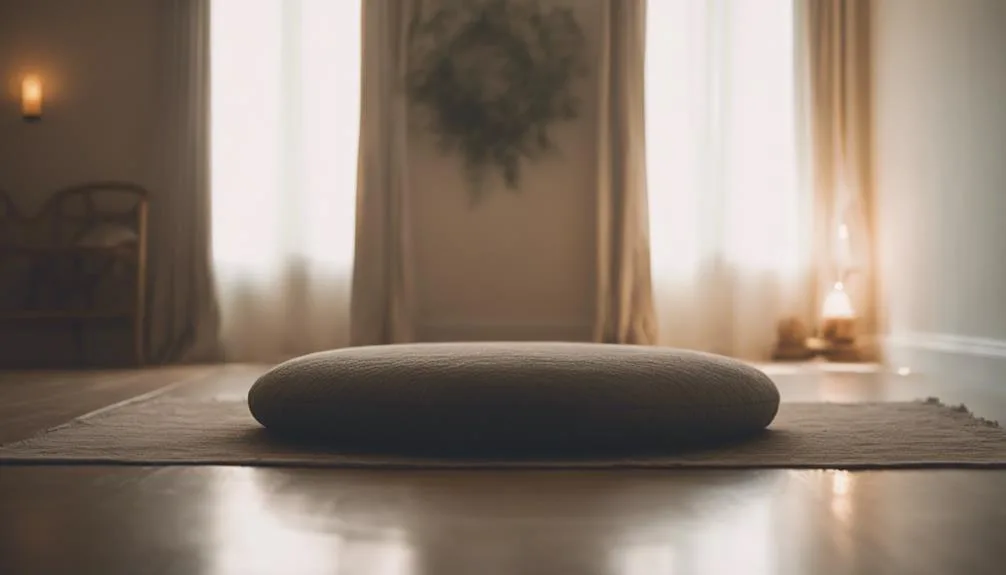Enhance Your Meditation Practice With Cushions
Meditation, a practice deeply ingrained in various cultural traditions, necessitates not only mental preparation but also physical support to achieve the deepest levels of concentration and relaxation.
Among the myriad aids to enhance this ancient discipline, the use of meditation cushions stands out for its role in facilitating the correct posture and comfort. The evolution of these cushions from simple natural materials to sophisticated ergonomic designs reveals a fascinating journey that mirrors the evolution of meditation practices themselves.
As we explore the significance of selecting the appropriate meditation cushion, we uncover how this seemingly simple tool can profoundly influence the quality of one's meditation experience, inviting a closer examination of its impact on posture, focus, and overall meditative success.
Key Takeaways
- Meditation cushions provide essential support for a straight back, enhancing stability and comfort during practice.
- Choosing the right cushion, considering materials and posture preferences, can significantly improve meditation focus and comfort.
- Regular use of a meditation cushion adapts the body for better comfort and focus in long meditation sessions.
- Testing various cushion types and materials helps identify the best fit for optimal meditation practice enhancement.
Historical Roots
Delving into the historical roots of meditation cushions reveals that Chinese nuns and monks were pioneers in their use, crafting hand-woven mats from dried grass to support their lengthy meditative practices. This ancient tradition underscores not only the practical necessity of such cushions for comfort and posture but also highlights their cultural significance within the realm of spiritual and contemplative practices.
These early adaptations by dedicated practitioners laid the foundational understanding of the physical aspects of meditation, recognizing the importance of aligning the body in a manner conducive to prolonged periods of introspection and mindfulness. The use of these simple yet effective tools reflects a deep reverence for the meditation process, illustrating a harmonious blend of practicality and spirituality that continues to inspire modern practices.
Cushion Types
When considering the diverse array of meditation cushions available, it is essential to understand the various types and their specific attributes to ensure optimal support and comfort during your practice. The choice between round vs square and firm vs soft cushions can significantly impact your meditation experience.
- Round cushions evoke a sense of traditional meditation practice, fostering a connection with age-old rituals.
- Square cushions offer a modern aesthetic, appealing to those seeking a contemporary meditation space.
- Firm cushions provide unwavering support, encouraging a posture that enhances deep concentration.
- Soft cushions invite a feeling of comfort and ease, allowing the body to relax more deeply into the practice.
Selecting the right type can be a deeply personal journey, reflecting one's meditation path and physical needs.
Material Insights

Understanding the various materials used in meditation cushions is crucial for selecting one that provides both comfort and support during your practice. With a variety of materials available, including kapok fiber, buckwheat hulls, wool, and cotton, each offers unique benefits.
For those prioritizing sustainability, eco-friendly options such as organic cotton or natural kapok fillings are ideal, aligning with a mindful lifestyle that respects the environment. Additionally, customization options allow for a personal touch in your meditation practice.
Whether it's choosing a specific material that contours to your body for enhanced comfort or selecting a cushion cover that reflects your personal style, these choices contribute to a more personalized and fulfilling meditation experience. Understanding these material insights ensures your cushion supports not just your body, but your practice's ethos too.
Adapting and Using
Having explored the various materials used in meditation cushions, we now focus on how to best adapt to and utilize these cushions in your daily practice for enhanced comfort and effectiveness. By carefully integrating these tools, you can significantly improve your meditation experience.
- *Embrace the journey towards improving posture*, allowing the cushion to support your spine's natural curvature.
- *Relish in the increased comfort* as the cushion contours to your body, reducing pressure points.
- *Celebrate the moments of deeper concentration* enabled by physical ease.
- *Treasure the personal growth* as you adapt, finding peace and stability in your practice.
Selecting the right cushion and adapting to its use can profoundly impact your meditation, enhancing both posture and comfort, leading to a more fulfilling practice.
Selection Tips

Selecting the ideal meditation cushion requires careful consideration of your unique posture needs and meditation style, ensuring both comfort and support throughout your practice. Begin by reflecting on your comfort preferences and how they align with your posture. A well-chosen cushion can significantly enhance posture alignment, facilitating a more focused and deeper meditation experience.
Understanding your meditation goals is crucial; whether you seek prolonged periods of stillness or dynamic movement meditations, the right cushion can make all the difference. We advise thorough cushion testing, experiencing various types firsthand to assess their support and comfort levels. This process is invaluable, as it directly influences your ability to maintain posture without discomfort, allowing you to fully immerse in your meditation practice.
Maintenance and Care
After choosing the ideal meditation cushion for your practice, it's essential to focus on proper maintenance and care to ensure its longevity and continued comfort. Proper upkeep not only preserves the cushion's quality but also enriches your meditation experience. Here are key aspects to consider:
- Follow manufacturer-specific cleaning tips to avoid damage while ensuring hygiene.
- Air out the cushion regularly to prevent moisture buildup and maintain freshness.
- Utilize appropriate storage solutions that protect the cushion from dust and direct sunlight.
- Handle with care during transport, using suitable bags or covers to avoid wear and tear.
Adhering to these guidelines will help maintain the integrity and comfort of your meditation cushion, supporting a serene and focused practice.
Frequently Asked Questions
How Can I Repurpose My Old Meditation Cushion for Other Household Uses Once It's No Longer Suitable for Meditation?
Repurposing your old meditation cushion can breathe new life into it. Consider transforming it into a cozy pet bed or decorative poufs, adding a touch of comfort and style to your home environment.
Are There Any Environmental Benefits to Choosing Certain Materials Over Others for Meditation Cushions?
Selecting meditation cushions made from materials with a long lifespan and sustainable sourcing offers environmental benefits. These choices reduce waste and promote eco-friendliness, aligning your meditation practice with principles of ecological responsibility and mindfulness.
Can Meditation Cushions Be Used for Purposes Other Than Meditation, Such as Desk Work or Dining Seating?
Meditation cushions can indeed serve multifunctional purposes beyond their traditional use, such as providing support as a travel pillow or acting as a yoga prop to enhance alignment and comfort during desk work or dining.
How Do Meditation Cushion Preferences Vary Across Different Meditation Traditions Around the World?
Meditation cushion preferences globally reflect diverse traditions and cultural symbolism, with history showing variations in materials and designs. Selecting a cushion involves understanding its historical roots and the symbolic values it carries within different meditative practices.
What Are Some Creative Ways to Personalize or Decorate My Meditation Cushion to Reflect My Personal Style or Spiritual Beliefs?
To personalize your meditation cushion, consider integrating color themes and fabric choices that resonate with your spiritual beliefs or personal style. Select materials that offer both comfort and a visual representation of your inner self.
Conclusion
In the garden of mindfulness, meditation cushions serve as the soil that nurtures the roots of tranquility and focus. Understanding the historical evolution, types, and materials of these cushions, alongside insights into their selection and maintenance, equips practitioners with the tools needed for a deeper meditative journey.
Embracing the right meditation cushion is akin to selecting a key that unlocks the door to enhanced comfort, flexibility, and concentration, ultimately enriching the meditative experience and fostering well-being.






